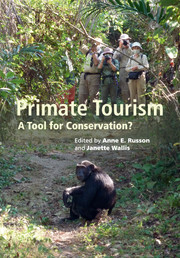18 - Primate tourism as a conservation tool
A review of the evidence, implications, and recommendations
from Part VI - Conclusion
Published online by Cambridge University Press: 05 September 2014
Summary
Introduction
Our aim in this book was to encourage balanced, empirically based assessments of primate tourism’s strengths and weaknesses as a primate conservation tool. Such assessments are increasingly called for, since nature tourism has not proven to be as low impact or as strong a conservation tool as previously hoped (Higham, 2007a; Knight & Cole, 1995). In this chapter we review primate tourism’s positive and adverse effects on primate conservation, primarily from the perspective of our contributors’ assessments of the species and sites they study. We focus on the primates and habitats visited and, where possible, weigh tourism’s adverse against positive effects. Insofar as this approach improves understanding of primate tourism’s impacts, it can serve as a basis for developing ways to operate primate tourism to the net benefit of primate conservation.
Assessing primate tourism’s conservation benefits and costs
Assessing the benefits and costs of primate tourism for primate conservation is complicated by the many factors and the long timeframes typically involved. Important complexities are that primate tourism is often only one of several activities at a site; primates are not necessarily the main tourist attraction; humans other than tourists may visit a site’s primates, such as researchers, conservationists, park employees, and local people; conservation may not be the main focus of primate tourism at a site; and patterns associated with primate tourism can also correlate with broader economic, socio-political, and natural events. It is not always possible to isolate which of these factors is responsible for changes relevant to primate conservation. An important case in point is disease transmission: human diseases have infected primates that tourists visit, but there is no evidence that tourists are more likely than non-tourists to have spread the diseases (Muehlenbein & Wallis, this volume).
- Type
- Chapter
- Information
- Primate TourismA Tool for Conservation?, pp. 313 - 332Publisher: Cambridge University PressPrint publication year: 2014
References
- 8
- Cited by



